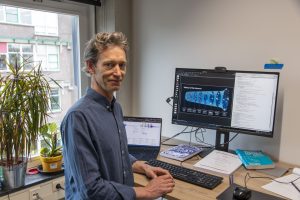Very optimistic about a big surprise, he is not. But the hunt for something new is wonderful work in itself, says VU professor of particle physics Wouter Hulsbergen. On April 25, he will hold his oration.
“The only directly useful thing I do is actually teaching,” Wouter Hulsbergen (54) says somewhere halfway through the interview, and he means it.
He is a physicist, investigating the difference between matter and antimatter in a large experiment at CERN. To better understand the universe. A splendid task.
But more importantly, to educate bright young people in the discipline of science. “We desperately need them as a society,” he says. He has been lecturing particle physics to VU and UvA students for years and regularly supervises PhD and master’s students.
LHCb experiment
Experimental physicist Hulsbergen has been an associate professor at the Vrije Universiteit since last year, but can mostly be found at Nikhef. There he is affiliated with the LHCb group, with some forty researchers from three Dutch universities. That contributes to one of the four large particle detectors at the lab in Geneva.

That international LHCb experiment involves hundreds of scientists from numerous countries, including the Netherlands. Hulsbergen is involved in the analyses of the particle collisions captured by the detector. And in the construction and improvements to the detector itself, for which parts are constructed in the Nikhef workshops in Amsterdam.
Geat mystery
That the universe seems to consist solely of matter is one of the great mysteries of physics, says Hulsbergen. “There are more questions where we don’t have answers. But this asymmetry is definitely a riddle in the left-hand row.”
Hulsbergen: “In the standard model of particles, the creation of particles and antiparticles is equally likely, but we only see matter. Where did the antimatter go and how? There must be a subtle difference somewhere, new physics that we as experimenters are trying to see.”
The LHCb experiment mainly looks at decay processes involving the beauty quark. In a large magnet, released particles are deflected, with matter and antimatter moving in opposite directions. In the separated particle tracks, differences between particles and antiparticles are sought.
Subtle differences
Those differences must be subtle, says Hulsbergen. “At least at the energy at which the current LHC accelerator at CERN operates, any deviations are small. That means you have to study a lot of collisions, including the very rare processes, to be able to say anything statistically about deviations.”
There are hints of anomalies here and there in the existing measurements from the LHCb, but not yet strong enough to think of new physics. “We know all too well that hints with more measurements can also easily disappear again, because we see a random outlier anyway,” says Hulsbergen. That can be frustrating, he acknowledges. “But also just really exciting to be working so on the edge of what we can know.”
Future proof
LHCb has been future-proofed in recent years for the improvements CERN will make to the LHC accelerator. The current version includes an improved central initial point detector, the VELO, built in large part in the Netherlands at Nikhef.
Hulsbergen knows the device like the back of his hand. “We have had the necessary problems, but now it does indeed work really better than the previous version, as was the intention.
A year from now, the LHC accelerator will go out of operation for years for a major rebuild to a machine with a much higher beam intensity. For LHCb, this HL-LHC accelerator is expected to provide five- to 10-fold more measurement data.
Giant leap
Hulsbergen: “That’s certainly a solid step, but whether it will be enough to find new physics, I don’t really know. The accuracy of measurements improves with the root of the amount of data. So it’s a step, but not a giant leap. So I’m not very confident that we’ll get much further.”
That said, real surprises beyond the Standard Model remain possible. New processes, such as for example a symmetry violation that varies in time, or really new particles, such as axions. LHCb and also other experiments are currently already trying to get fingers on that.
Hulsbergen: “Those are not things that come up in my own analyses. But if we find something it would of course be tremendously interesting. Preferably before my retirement in fifteen years. And that would require some luck.”